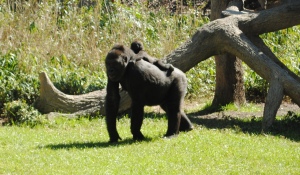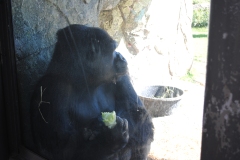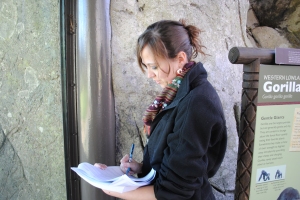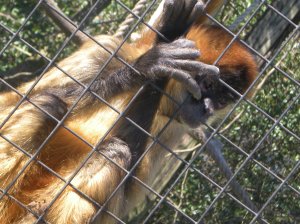 I spent this past weekend in North Carolina where Brian and I visited the NC Zoo so I could work on my Primate Observation Project for my Primatology class. This trip was far more successful than my trip to the Gulf Breeze Zoo in Pensacola. Besides the park-wide power outage, we were able to spend a couple of hours observing and recording the group of gorillas that were very active that morning.
I spent this past weekend in North Carolina where Brian and I visited the NC Zoo so I could work on my Primate Observation Project for my Primatology class. This trip was far more successful than my trip to the Gulf Breeze Zoo in Pensacola. Besides the park-wide power outage, we were able to spend a couple of hours observing and recording the group of gorillas that were very active that morning.
This troop consisted of 6 individuals: 1 adult silverback male, 3 adult females, and 2 male infants. The infants belong to two of the females and the third female is pregnant and due to give birth in the summer, the silverback is the father of all the infants. The infants are still very new and the mothers are just starting to allow the infants to explore the enclosure. When they were not exploring, they were being carried on the mother’s back. However, they are a BIG distraction due to their cuteness and they took a lot of my attention away from the rest of the observation of the other individuals. Nonetheless, they were adorable to watch. Numerous times one of the infants would go into in the tall grass and all all you could see is the grass move where he was. The other mother-infant dyad were in the western end of the enclosure and out of sight for the majority of my observation, so I wasn’t able to watch them as closely as I got to with the other mother-infant dyad that stayed a majority of time in my line of sight and around the tall grass towards the middle of the enclosure. As the infants played in the grass, the mother wasn’t too far behind and always keeping a watchful eye. Mother was usually eating in order to provide breast milk for the infant. So as the mother foraged, the infants were put down to explore. At one point one other mothers did place her infant in front of her to groom for about a minute before the infant got distracted to go explore the tall grass once again.
and the mothers are just starting to allow the infants to explore the enclosure. When they were not exploring, they were being carried on the mother’s back. However, they are a BIG distraction due to their cuteness and they took a lot of my attention away from the rest of the observation of the other individuals. Nonetheless, they were adorable to watch. Numerous times one of the infants would go into in the tall grass and all all you could see is the grass move where he was. The other mother-infant dyad were in the western end of the enclosure and out of sight for the majority of my observation, so I wasn’t able to watch them as closely as I got to with the other mother-infant dyad that stayed a majority of time in my line of sight and around the tall grass towards the middle of the enclosure. As the infants played in the grass, the mother wasn’t too far behind and always keeping a watchful eye. Mother was usually eating in order to provide breast milk for the infant. So as the mother foraged, the infants were put down to explore. At one point one other mothers did place her infant in front of her to groom for about a minute before the infant got distracted to go explore the tall grass once again.
 As I had mentioned before, the male silverback is the father of all both male infants as well as the father of the pregnant third female. For the majority of the time that I spent observing, he spent his time either sitting in the southern corner where the glass observation was or laying down. When he was sitting there, he would be facing out into the enclosure watching the other individuals. At one time he did get up and walk around the entire perimeter always looking at one of the females, before he settled back into the corner. He slept for a good 10 minutes of my first observational session and again for 20 minutes into my second observational session. He either sat and ate or slept, but always facing out into the enclosure. He is the alpha male of this troop and the father of the infants. The keeper/trainer of the gorillas was out at the observation window and informed me that the male does often hold and play with the infants. But a majority of the time the infants stay with the mother and the father will occasionally interact with the infants. He is the ever watchful protector of this group.
As I had mentioned before, the male silverback is the father of all both male infants as well as the father of the pregnant third female. For the majority of the time that I spent observing, he spent his time either sitting in the southern corner where the glass observation was or laying down. When he was sitting there, he would be facing out into the enclosure watching the other individuals. At one time he did get up and walk around the entire perimeter always looking at one of the females, before he settled back into the corner. He slept for a good 10 minutes of my first observational session and again for 20 minutes into my second observational session. He either sat and ate or slept, but always facing out into the enclosure. He is the alpha male of this troop and the father of the infants. The keeper/trainer of the gorillas was out at the observation window and informed me that the male does often hold and play with the infants. But a majority of the time the infants stay with the mother and the father will occasionally interact with the infants. He is the ever watchful protector of this group.
The pregnant female was out of my sight most of the time at the other end of the enclosure where I could not see past the  stone corner. She spent most of the time eating and foraging in the tall grass. Towards the end of my first session, she walked over and laid down in the opposing corner of the silverback, (the southern observational window) where she also preceded to sleep as well. She slept the rest of the my first session about 10 minutes and about 15 minutes into my second session. The rest of the second session she moved from that corner either just sitting and watching or moving toward the tall grass in the center of the enclosure to forage and eat. She is pregnant so she needs to eat as much as she can and rest. (In this picture you can see her pregnant belly).
stone corner. She spent most of the time eating and foraging in the tall grass. Towards the end of my first session, she walked over and laid down in the opposing corner of the silverback, (the southern observational window) where she also preceded to sleep as well. She slept the rest of the my first session about 10 minutes and about 15 minutes into my second session. The rest of the second session she moved from that corner either just sitting and watching or moving toward the tall grass in the center of the enclosure to forage and eat. She is pregnant so she needs to eat as much as she can and rest. (In this picture you can see her pregnant belly).
Fun Fact: gestation period for a gorilla is about 8.5 months.
I have had some people ask me before when I originally posted about the primate  project at the Gulf Breeze Zoo, what exactly what I was doing just watching the gorillas. But I was actually assigned to implore and observational method to record the gorillas’ behaviors as a group. This method that I was assigned was an instantaneous (scan) method in which I have to watch the behaviors of each individuals in time intervals of one minute for 30 minutes. Every time a minute was up, I would record a new set of behaviors as quickly as possible. What I have described before with the behaviors of the apes, are the interpretations of what I had observed. I feel like it was a lot like scanning as a lifeguard of a crowded pool, but with gorillas. The good thing was that they really just eat, sit, and rest. The infants were the only individuals that really moved around and were hyper. As a result, observation was not only easy but it was easier to see the whole group during the limited time intervals.
project at the Gulf Breeze Zoo, what exactly what I was doing just watching the gorillas. But I was actually assigned to implore and observational method to record the gorillas’ behaviors as a group. This method that I was assigned was an instantaneous (scan) method in which I have to watch the behaviors of each individuals in time intervals of one minute for 30 minutes. Every time a minute was up, I would record a new set of behaviors as quickly as possible. What I have described before with the behaviors of the apes, are the interpretations of what I had observed. I feel like it was a lot like scanning as a lifeguard of a crowded pool, but with gorillas. The good thing was that they really just eat, sit, and rest. The infants were the only individuals that really moved around and were hyper. As a result, observation was not only easy but it was easier to see the whole group during the limited time intervals.
Overall, this trip was very successful as well as fun. Brian was able to help me with the timing intervals and taking pictures of the gorillas. When we were done with the observation project. We did explore the rest of the zoo. It is not the most impressive zoo, there is a lot of walking and hiking between the exhibits. But it was fun and the power did come on eventually, so we didn’t have to use the restrooms in the dark. We were there at mid-day (between 11-2pm) the time when it seemed to be nap time for a majority of the animals. So the animals as a whole were not very active. But I was satisfied and got to do my project.



